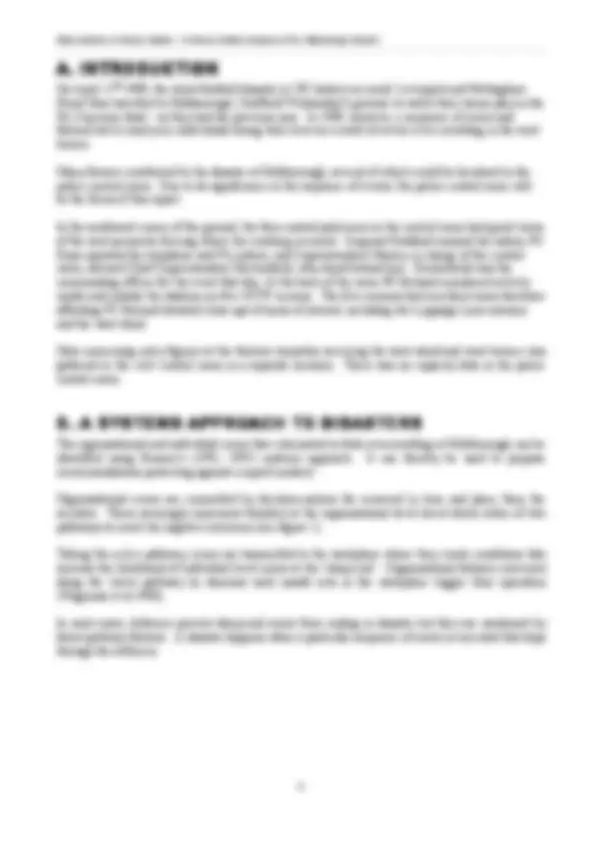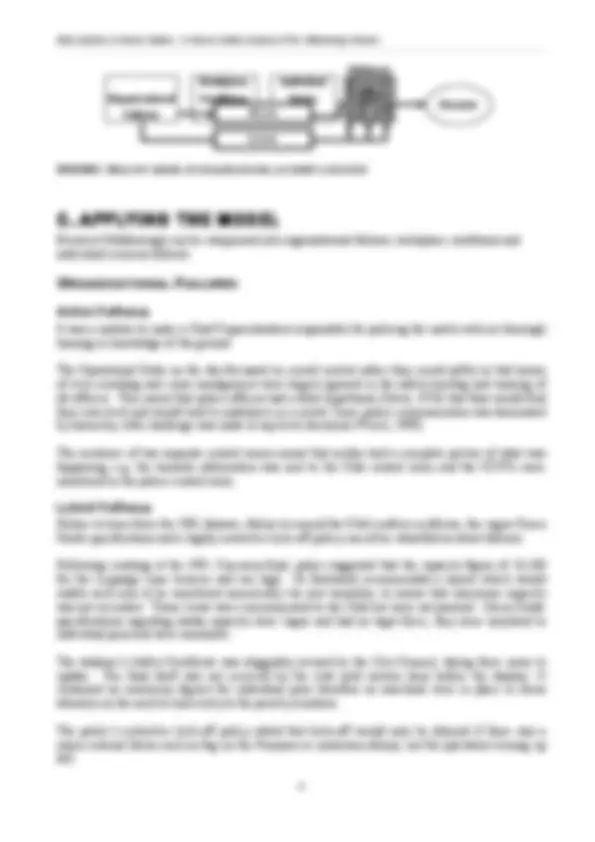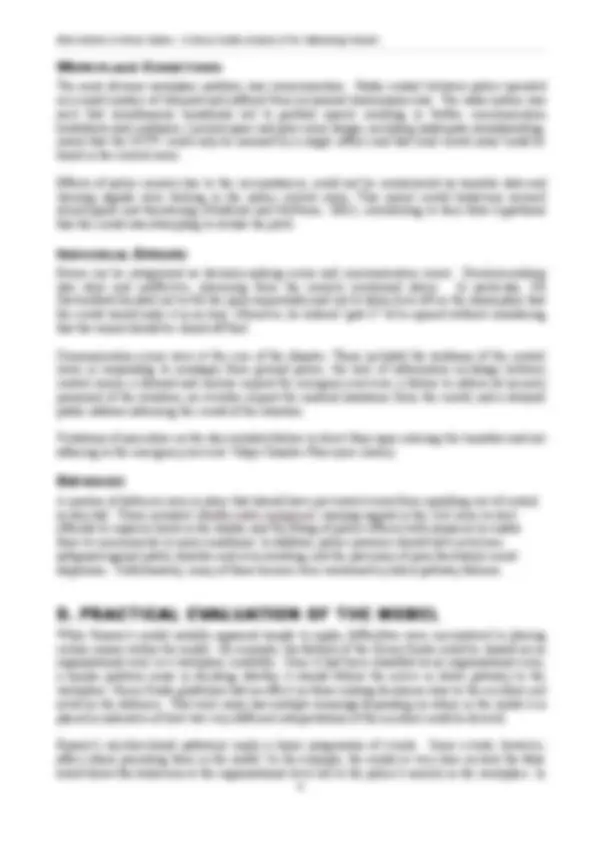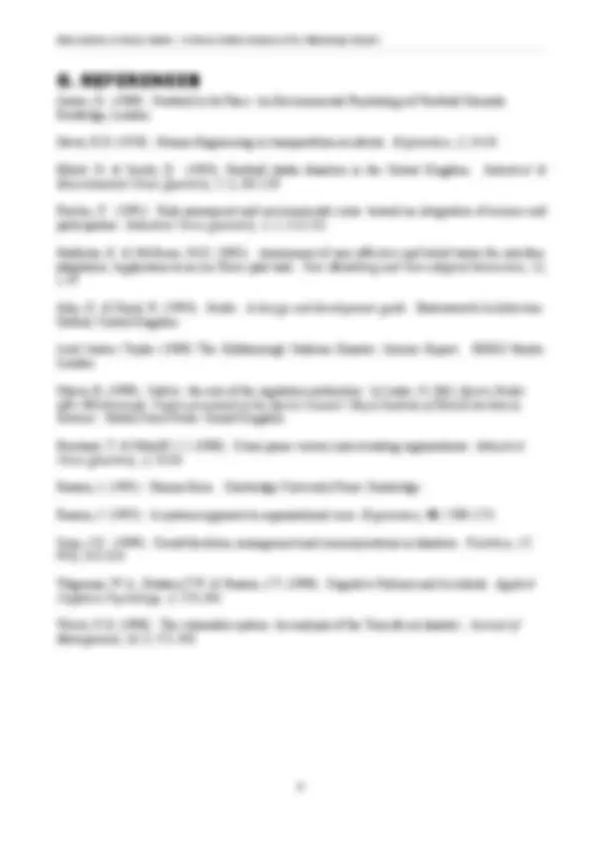







Study with the several resources on Docsity

Earn points by helping other students or get them with a premium plan


Prepare for your exams
Study with the several resources on Docsity

Earn points to download
Earn points by helping other students or get them with a premium plan
Community
Ask the community for help and clear up your study doubts
Discover the best universities in your country according to Docsity users
Free resources
Download our free guides on studying techniques, anxiety management strategies, and thesis advice from Docsity tutors
In 1989, however, a sequence of errors and failures led to ninety-six individuals losing their lives as a result of severe over-crowding in the west terrace.
Typology: Exercises
1 / 9

This page cannot be seen from the preview
Don't miss anything!






FIGURE 1: REASON’S MODEL OF ORGANISATIONAL ACCIDENT CAUSATION
C. APPLYING THE MODEC. APPLYING THE MODEC. APPLYING THE MODEC. APPLYING THE MODELLLL
Events at Hillsborough can be categorised into organisational failures, workplace conditions and individual errors as follows:
Active Pathway
It was a mistake to make a Chief Superintendent responsible for policing the match with no thorough training or knowledge of the ground.
The Operational Order on the day focussed on crowd control rather than crowd safety in that issues of over-crowding and crisis management were largely ignored in the safety briefing and training of all officers. This meant that police officers had a false hypothesis (Davis, 1958) that fans would find their own level and would tend to misbehave in a crowd. Since police communication was dominated by hierarchy, little challenge was made to top-level decisions (Weick, 1990).
The existence of two separate control rooms meant that neither had a complete picture of what was happening, e.g. the turnstile information was sent to the Club control room and the CCTVs were monitored in the police control room.
Latent Pathway
Failure to learn from the 1981 disaster, failure to amend the Club’s safety certificate, the vague Green Guide specifications and a highly restrictive kick-off policy can all be classified as latent failures.
Following crushing at the 1981 Cup semi-final, police suggested that the capacity figure of 10, for the Leppings Lane terraces was too high. Dr Eastwood recommended a layout which would enable each area to be monitored numerically via new turnstiles, to ensure that maximum capacity was not exceeded. These views were communicated to the Club but were not pursued. Green Guide specifications regarding stadia capacity were vague and had no legal force, they were unrelated to individual pens and were unrealistic.
The stadium’s Safety Certificate was sluggishly revised by the City Council, taking three years to update. The final draft was not received by the club until sixteen days before the disaster. It contained no maximum figures for individual pens therefore no sanctions were in place to focus attention on the need to limit entry to the pens by numbers.
The police’s restrictive kick-off policy stated that kick-off would only be delayed if there was a major external factor such as fog on the Pennines or motorway delays, not for spectators turning up late.
Organisational Disaster Failures
Workplace Conditions
Individual Errors ACTIVE
LATENT
Defences
The most obvious workplace problem was communication. Radio contact between police operated on a small number of channels and suffered from occasional transmission loss. The radio system was such that simultaneous broadcasts led to garbled speech resulting in further communication breakdown and confusion. Limited space and poor room design, including inadequate soundproofing, meant that the CCTV could only be manned by a single officer and that loud crowd noise could be heard in the control room.
Effects of police anxiety due to the circumstances, could not be counteracted as turnstile data and warning signals were lacking in the police control room. This meant crowd behaviour seemed stereotypical and threatening (Hudlicka and McNeese, 2002), contributing to their false hypothesis that the crowd was attempting to invade the pitch.
Errors can be categorized as decision-making errors and communication errors. Decision-making was slow and ineffective, stemming from the anxiety mentioned above. In particular, Mr Duckenfield decided not to fill the pens sequentially and not to delay kick-off on the assumption that the crowd would make it in on time. Moreover, he ordered ‘gate C’ to be opened without considering that the tunnel should be closed off first.
Communication errors were at the core of the disaster. These included the tardiness of the control room in responding to messages from ground police; the lack of information exchange between control rooms; a delayed and unclear request for emergency services; a failure to inform all security personnel of the situation; an overdue request for medical assistance from the crowd; and a delayed public address informing the crowd of the situation.
Violations of procedure on the day included failure to direct fans upon entering the turnstiles and not adhering to the emergency services’ Major Disaster Plan more closely.
A number of defences were in place that should have prevented events from spiralling out of control as they did. These included: standby radio equipment; warning signals in the club room to alert officials to capacity limits in the stands; and the fitting of police officers with earpieces to enable them to communicate in noisy conditions. In addition, police presence should have acted as a safeguard against public disorder and overcrowding, and the provision of pens facilitated crowd dispersion. Unfortunately, many of these barriers were weakened by latent pathway failures.
D. PRACTICAL EVALUATD. PRACTICAL EVALUATD. PRACTICAL EVALUATD. PRACTICAL EVALUATION OF THE MODELION OF THE MODELION OF THE MODELION OF THE MODEL
While Reason’s model initially appeared simple to apply, difficulties were encountered in placing certain causes within the model - for example, the failures of the Green Guide could be classed as an organisational error or a workplace condition. Once it had been classified as an organisational error, a similar problem arose in deciding whether it should follow the active or latent pathway to the workplace. Green Guide guidelines had an effect on those making decisions close to the accident and acted on the defences. That each cause has multiple meanings depending on where in the model it is placed is indicative of how two very different interpretations of the accident could be derived.
Reason’s uni-directional pathways imply a linear progression of events. Some events, however, affect others preceding them in the model. So for example, the model is very clear on how the false belief about fan behaviour at the organisational level led to the police’s anxiety in the workplace. In
Prior to every match the control room should liase with the emergency services to communicate details of the event, i.e. location, time, number of spectators, routes of entry and exit and any anticipated difficulties.
There should be a public address system to communicate with the crowd, with important announcements preceded by a loud signal to catch their attention despite high noise levels; this code should be advertised on all match programmes. Illuminated advertising boards should also be utilised. Delayed and poor warnings, with the intent of avoiding panic, are self-fulfilling in the sense that flight or panic behaviour is the only logical response when the situation gets out of control (Sime, 1999).
The control room is in clear need of redesign and some guidelines for this can be found in recent design literature. For optimum performance, and to minimise communication problems, the police and club control rooms should be combined and enlarged to a minimum of 15m^2 (John and Sherd, 1994), which may necessitate relocation. An authority-holding member of the club should be present to aid larger numbers of police and security in decision-making (Myers, 1990). Finally, all information and controls should come through this single sound-proofed room - monitoring equipment, internal and external phone-lines, audio and visual public address and all other communication and technological systems. This is the only way that integrated and informed emergency response can occur (John and Sherd, 1994).
The equipment itself should be designed to draw attention to any problems, taking into account beliefs and emotions that may cloud judgement in an emergency. Warning signals for full pens and presentation of CCTV can and should be used to prevent misinformed and heuristic-led decision- making (Hudlicka and McNeese, 2002). Where emergency and precautionary information would not be immediately visible, appropriate training should be given.
F. CONCLUSIONF. CONCLUSIONF. CONCLUSIONF. CONCLUSION
Using Reason’s Model of Organisational Accident Causation, this report has categorised the organisational failures, workplace conditions, individual and team errors and the weak defences that accumulated to cause the Hillsborough disaster of 1989. The aim of this model is not to attribute blame, but to highlight how an almost infinite number of factors are inextricably linked in the process of disaster causation. By examining the structure and culture of the organisation using a blame-free framework Reason (1995) strives to ensure that learning occurs within it. Further, Pauchant & Mitroff (1988) suggest that the identification of latent errors leads to the creation of a more robust, crisis prepared organization.
It is recommended that technological improvements are needed in the control room but the culture of technocracy (Fischer, 1991) can easily lure organisations into a false sense of security. Canter (1989) warns that once the issue of crowd safety and control is seen as a technical problem, then the mind set becomes one that seeks only technical solutions. While convincing in the wake of a disaster, these are inadequate in the long-term as elements of the organisation such as culture, communication and configuration, need to be addressed. ‘Solutions’ that fail to change the core values, behaviour and assumptions of the organisation only serve to create a climate of disaster incubation.
In recommending greater top-level safety commitment and laying down clearer guidelines as to responsibilities and capacity regulation, it is hoped that the adverse consequences of organisational errors can be avoided in the future. The football industry, and Sheffield Wednesday in particular,
owes it to those who have lost their lives, that further loss-of-life events are prevented by making changes at the core rather than at the periphery (Elliott & Smith, 1993).